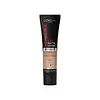What's inside
What's inside
 Key Ingredients
Key Ingredients

 Benefits
Benefits

 Concerns
Concerns

 Ingredients Side-by-side
Ingredients Side-by-side

Talc
AbrasiveMagnesium/Potassium/Silicon/Fluoride/Hydroxide/Oxide
Mica
Cosmetic ColorantCI 77499
Cosmetic ColorantPentaerythrityl Tetraethylhexanoate
EmollientCI 77492
Cosmetic ColorantCI 77891
Cosmetic ColorantNylon-12
Magnesium Myristate
Dimethicone/Vinyl Dimethicone Crosspolymer
Skin ConditioningHydroxyapatite
AbrasiveCI 77491
Cosmetic ColorantDiisostearyl Malate
EmollientCI 77007
Cosmetic ColorantTriethoxycaprylylsilane
Hydrogen Dimethicone
Dimethicone
EmollientEthylhexylglycerin
Skin ConditioningGlyceryl Caprylate
EmollientIsopropyl Titanium Triisostearate
EmollientSilica
AbrasiveMyristic Acid
CleansingTalc, Magnesium/Potassium/Silicon/Fluoride/Hydroxide/Oxide, Mica, CI 77499, Pentaerythrityl Tetraethylhexanoate, CI 77492, CI 77891, Nylon-12, Magnesium Myristate, Dimethicone/Vinyl Dimethicone Crosspolymer, Hydroxyapatite, CI 77491, Diisostearyl Malate, CI 77007, Triethoxycaprylylsilane, Hydrogen Dimethicone, Dimethicone, Ethylhexylglycerin, Glyceryl Caprylate, Isopropyl Titanium Triisostearate, Silica, Myristic Acid
Water
Skin ConditioningDimethicone
EmollientIsododecane
EmollientAcrylates/Polytrimethylsiloxymethacrylate Copolymer
Skin ConditioningButylene Glycol
HumectantSilica
AbrasivePEG-10 Dimethicone
Skin ConditioningSynthetic Fluorphlogopite
Isohexadecane
EmollientCellulose
AbsorbentIsononyl Isononanoate
EmollientPentylene Glycol
Skin ConditioningBis-PEG/PPG-14/14 Dimethicone
EmollientMagnesium Sulfate
Phenoxyethanol
PreservativeDisodium Stearoyl Glutamate
CleansingCaprylyl Glycol
EmollientSilica Silylate
EmollientDisteardimonium Hectorite
StabilisingCalcium Aluminum Borosilicate
Tocopherol
AntioxidantHydroxyethyl Acrylate/Sodium Acryloyldimethyl Taurate Copolymer
Emulsion StabilisingParfum
MaskingAluminum Hydroxide
EmollientHexyl Cinnamal
PerfumingBenzyl Salicylate
PerfumingLinalool
PerfumingSorbitan Isostearate
EmulsifyingWater, Dimethicone, Isododecane, Acrylates/Polytrimethylsiloxymethacrylate Copolymer, Butylene Glycol, Silica, PEG-10 Dimethicone, Synthetic Fluorphlogopite, Isohexadecane, Cellulose, Isononyl Isononanoate, Pentylene Glycol, Bis-PEG/PPG-14/14 Dimethicone, Magnesium Sulfate, Phenoxyethanol, Disodium Stearoyl Glutamate, Caprylyl Glycol, Silica Silylate, Disteardimonium Hectorite, Calcium Aluminum Borosilicate, Tocopherol, Hydroxyethyl Acrylate/Sodium Acryloyldimethyl Taurate Copolymer, Parfum, Aluminum Hydroxide, Hexyl Cinnamal, Benzyl Salicylate, Linalool, Sorbitan Isostearate
 Reviews
Reviews

Ingredients Explained
These ingredients are found in both products.
Ingredients higher up in an ingredient list are typically present in a larger amount.
Dimethicone is a type of synthetic silicone created from natural materials such as quartz.
What it does:
Dimethicone comes in different viscosities:
Depending on the viscosity, dimethicone has different properties.
Ingredients lists don't always show which type is used, so we recommend reaching out to the brand if you have questions about the viscosity.
This ingredient is unlikely to cause irritation because it does not get absorbed into skin. However, people with silicone allergies should be careful about using this ingredient.
Note: Dimethicone may contribute to pilling. This is because it is not oil or water soluble, so pilling may occur when layered with products. When mixed with heavy oils in a formula, the outcome is also quite greasy.
Learn more about DimethiconeSilica, also known as silicon dioxide, is a naturally occurring mineral. It is used as a fine, spherical, and porous powder in cosmetics.
Though it has exfoliant properties, the function of silica varies depending on the product.
The unique structure of silica enhances the spreadability and adds smoothness, making it a great texture enhancer.
It is also used as an active carrier, emulsifier, and mattifier due to its ability to absorb excess oil.
In some products, tiny microneedles called spicules are made from silica or hydrolyzed sponge. When you rub them in, they lightly polish away dead skin layers and enhance the penetration of active ingredients.
Learn more about Silica